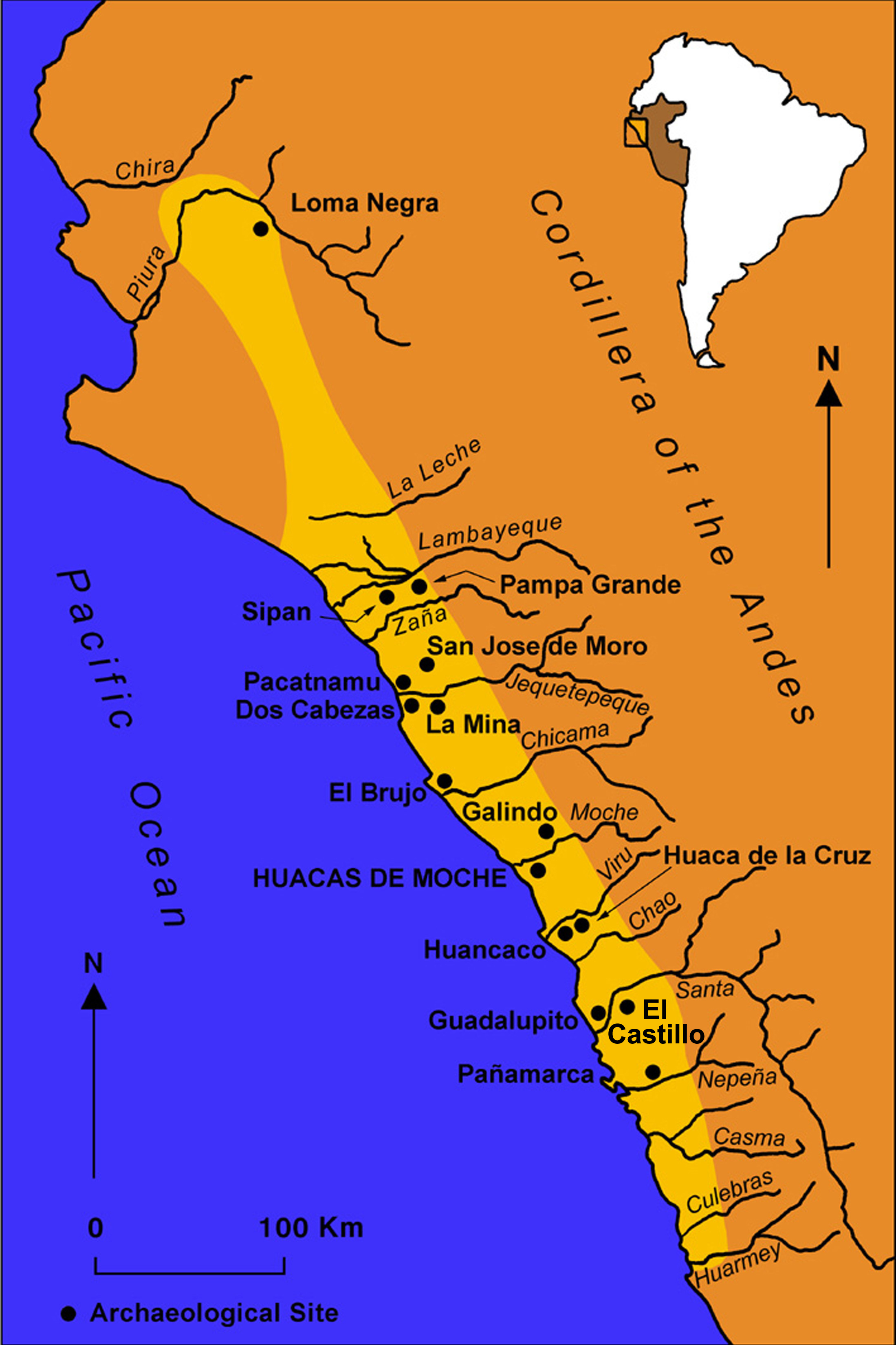1,500-Year-Old Moche Indian Lord’s Tomb Discovered in Peru
posted on May 29th, 2009 in Archaeology, Northern Kingdoms of Peru, Peru, Recent Discoveries
“King of Bling” Tomb Sheds Light on Ancient Peru
National Geographic News
April 10, 2009
Packed with treasure in the styles of two ancient orders, the 1,500-year-old tomb of the Moche Indian “king of bling” is like no other, according to archaeologist Steve Bourget.
Discovered in Peru at the base of an eroded mud-brick pyramid, the tomb gradually yielded its contents last summer.
Among the finds: 19 golden headdresses, various pieces of jewelry, and two funerary masks, as well as skeletons of two other men and a pregnant woman.
The tomb’s mysterious contents and location—far from known Moche capitals—could shed new light on this little-known culture of Peru’s arid northern coast, said Bourget, of the University of Texas at Austin.
Thriving between A.D. 100 and 800, the highly agricultural Moche Indians are known in large part by their stepped pyramids, jewelry-filled tombs, and exquisite pottery and art.
Lord of Ucupe
Located some 475 miles (750 kilometers) north of Lima, the newfound tomb was found at the base of Huaca el Pueblo, a mud-brick, stepped pyramid that has eroded into a high, round mound.
The Lord of Ucupe—as locals have come to call the entombed Moche leader—was in his early thirties when he died, Bourget said.
For entombment, the lord was dressed in full regalia—and then some.
His body was covered with a tunic and train of tiny gilded copper plates, and his face was covered with two funerary masks—a first, according to Bourget. A necklace of four-inch (ten-centimeter), disk-shaped silver rattles encircled his neck.
On his head was a gilded crown. Six more crowns and ten V-shaped headdresses called diadems were arrayed on top of his body. Still another diadem was folded in half and placed atop six metal war clubs to serve as a mat for his lifeless body.
Some of the Lord of Ucupe’s copper and gold burial ornaments
The Lord of Ucupe was then wrapped in a large bundle made of reed and textile, along with artifacts suggestive of political status, said Bourget, who co-led the team that found the tomb with Bruno Alva of the Museum Tumbas Reales de Sipán.
Atop it all was placed a final diadem, the first treasure found by the archaeologists as they brushed away the layers of dirt—probably from a cave-in, Bourget said—filling the originally hollow tomb.
Sandwiched
The lord was entombed atop another man. At the second man’s side was yet another man, who himself was atop a pregnant woman.
“We don’t know the relationships between the leader and the other males,” Bourget said. And “this woman may have been a concubine or a wife. She may have died [of natural causes] while pregnant.”
There were no marks on the bones indicating that the people had been sacrificed, he said, adding that textile fragments from around the bodies were radiocarbon dated to A.D. 340 to 540.
King of Bling
In life, the Lord of Ucupe would probably not have ventured out of his elevated palace unless arrayed much as he was in death, Bourget believes.
Nearly everything the lord wore—tunic, headdress, ear spools, nose mask—would have been made of gilded copper, he said.
“This guy would have shined in the sunlight”—to dazzle and distract, Bourget said.
“This is the king of bling, literally.”
Moche Funeary mask of the Lord of Ucupe
Even his jingling necklace and handheld metal rattles served to inspire awe, Bourget said. Because of metal’s scarcity, “no commoner could ever make this noise.”
A First
The styles and funeral arrangements found at Huaca el Pueblo are similar to those at the famed Moche site of Sipán, some 25 miles (40 kilometers) away.
But archaeologists have never before unearthed anything like the Lord of Ucupe, Bourget said.
“This find is particularly important, because it is the first time we have found an individual outside of Sipán that is the same type as some of the leaders found in Sipán,” he said.
But even in storied Sipán, he said, it’s unheard of to find so many precious funerary ornaments in a single Moche tomb.
What’s more, the artifacts are a jumble of both the more florid early Moche style and the stylistically simpler middle Moche designs.
Bourget suspects the inclusion of both styles was a political act, perhaps designed to help legitimize the new order by linking it with the old.
Theories Debunked?
Similarities between the Lord of Ucupe’s tomb and Sipán sites may challenge a widely held theory that northern Moche settlements were highly independent.
“I don’t think the idea that they were organized into city-states will fly anymore,” Bourget said.
Jeffrey Quilter, deputy director of the Peabody Museum of Archaeology and Ethnology at Harvard University, wouldn’t go quite that far.
Still, Quilter said, “Finding what appears to be a local lord who was part of a larger cultural system but may have been relatively independent—or maybe not—will … be a great contribution to understanding the past.”
Charles Stanish, director of the Cotsen Institute of Archaeology at the University of California, Los Angeles, largely agrees with Bourget.
Referring to medieval European kingdoms, Stanish said “the Moche could have been similarly organized, with semi-autonomous [settlements] being linked by ideology, artifacts, and ways of acting.”

